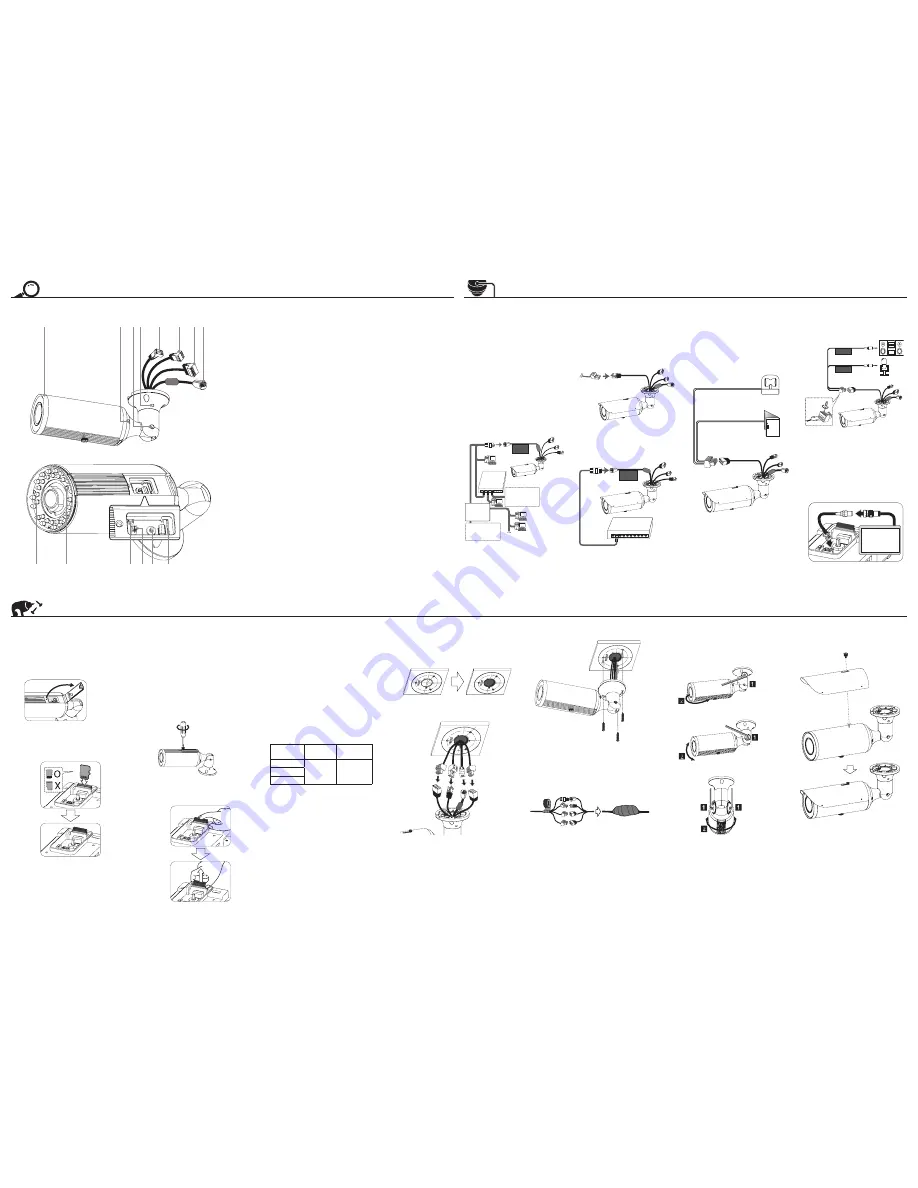
Part Names and Functions
i
j
m
k
n
a
b
c d
e
f
g h
l
a
Lens Cover
b
Angle adjuster
Adjust the camera angle.
c
Tilt adjuster
Adjust the tilt position.
d
Pan adjuster
Adjust the pan position.
e
Power input terminal
Connects to DC 12 V or AC 24 V power supply using proper cables. This camera must always
be operated DC 12 V or AC 24 V. Certified/Listed Adaptor which comply with LPS.
f
AUDIO IN / OUT (Line Level Input / Output)
g
ALARM IN & OUT / ALARM IN & OUT RETURN
Provides physical interface for sensor and Alarm/Relay.
h
ETHERNET / PoE Port
Connects to a PC or a network via a hub with a 10 BASE-T / 100 BASE-TX cable attached RJ-45
connector.
NOTE:
Power over Ethernet (PoE) is a technology that integrates power into a standard LAN
infrastructure. It enables power to be provided to the network device, such as a network
camera, using the same cable as that used for network connection. It eliminates the need for
power outlets at the device locations and enables easier application of uninterruptible power
supplies (LPS).
i
IR LED
NOTE:
Do not stare at operating IR LED within hazard distances (1 m).
j
IR Sensor
k
RESET button
Push the button more than 3 seconds, this would restore the factory default network related
settings.
l
Video Out Connector
Use this jack for checking the picture with portable monitor when install the camera.
m
Jog button
Use this button for control the Zoom / Focus of the camera.
n
micro SD card slot
Insert the micro SD card.
Installation
Using the micro SD card
You can record your surveillance environment with
the micro SD card even if the network is disconnected
condition.
To insert the micro SD card
1. Open the Cover on the main body by loosening
the screw.
2. Insert the micro SD card carefully as shown in the
following illustrations. Make sure the micro SD
card terminal position before insert the micro SD
card. Push the back end of the micro SD card to
fix it at the last step.
NOTES:
•
Do not use the power too much when you insert
the micro SD card. The micro SD card may be
damaged.
•
If you insert the micro SD card in the wrong
position, the micro SD card may be damaged
or it may cause the malfunction of the micro SD
Card Slot.
•
Keep the terminal part of the micro SD card in
clean. Be careful the terminal part of the micro SD
card not to dusty.
•
As the micro SD card is consumable, the micro
SD card end its days and may be not able to save
data if you use it more than over certain times.
In this case, replace micro SD card to buy a new
one.
•
Close the cover and fasten the screw securely
using a screwdriver as shown below.
Remove the micro SD card
1. Press the back end of the micro SD card to
release the lock condition.
2. Take the micro SD card out carefully from the
camera. It may cause a malfunction of the micro
SD card or the micro SD card slot if you use the
power too much at lock status.
CAUTION:
•
If you install the micro SD card on the camera
and remove with the micro SD card condition
indicator lights on, you must unmount the micro
SD card by using the [System > Storage > Device
Management > Unmount] menu. The micro SD
card data is compromised or the camera may not
operate normally, if you remove the card without
use [Unmount] function.
•
LG Electronics is not responsible for deleted data
caused by user mishandling when you insert or
remove the micro SD card.
Recommended the micro SD card specification
Maker
Capacity
Block Size
(FAT 32)
LG
Less than
32 GB
32 kbyte
Sandisk
Transcend
NOTE:
Speed of reading and writing more than 10 MB/Sec.
(Class 6)
Follow the instructions below to ceiling or wall mount
the camera.
Mounting the Camera
1. Using a template as a guide, make a hole through
the ceiling.
2. Connect the cables to the cable jacks of the
camera body.
3. Install the camera by using M4 Tapping screws to
fix it on the ceiling.
Connecting Waterproof processing
of cable
Surely use the Butyl tape.
1. Connect the cables.
2. Bind the cables together with Butyl tape.
WARNING:
•
The cables are not waterproofed completely. So
seal the tube ends and the portions between
cable cores as well as connecting portions with
Butyl tape.
•
If not using the Butyl tape, it may cause water
absorption from a gap and finally condensation
and water leakage.
Adjust the camera position
You should adjust the camera angle position as shown
below illustration. Adjust the camera angle position by
following step
a
and
b
.
1. Adjust the Pan.
2. Adjust the Tilt.
3. Adjust the Angle.
NOTE:
•
The camera could be damaged by adjusting Pan,
Tilt by force.
•
Camera can be damaged if you adjust the Pan
/ Tilt / Angle when the screw is fixed.
•
Be careful not to rotate the Pan and Angle more
than 360°, it may damage the internal cable.
Assemble the Sunshield
Adjust the position of the Sunshield, then assemble
the Sunshield.
Connection
Precautions
•
Be sure to switch off the unit before
installation and connection.
•
The installation should be made by
qualified service personnel or system
installers.
•
Do not expose the power and connection
cables to moisture, which may cause
damage to the unit.
Connecting Network
You can control and monitor the system via
network. With the remote control (monitoring),
you can change the system configuration
or monitor the image via network. After the
installation, check the network settings for the
remote control and monitoring work.
Connect the IP camera to your network using a
standard RJ-45 network cable as shown below.
ETHERNET
With PoE
PoE Device
(IEEE802.3af)
Broadband
Service
Broadband
Service
Router
Connecting Power Source
Connect power, using one of the methods
listed below:
To use the power adapter
Connect DC 12 V or AC 24 V power source to
the power input terminal as shown below.
(recommended power adapter is DC 12 V or
AC 24 V / 1.5 A or above)
ETHERNET
With PoE
To use the PoE (Power over Ethernet) device
Connect the PoE cable to the LAN port on the
unit. You must use the “IEEE802.3af” standard
PoE device.
ETHERNET
With PoE
PoE Device
(IEEE802.3af )
NOTE:
If the camera doesn’t work properly after
connecting PoE device, please check if the PoE
device supplies enough power.
Connecting Alarm Device
Alarm terminals are used to connect the alarm
(relay) devices such as sensors, door switches,
etc.
ALARM IN & OUT / ALARM IN & OUT RE-
TURN (Sensor Input/ Relay Output)
Connect the sensor device and alarm (relay)
device to the alarm terminal. Alarm signal is
outputted at an event occurrence.
Sensor Device
Alarm (relay)
Device
NOTE:
The Photo MOS Relay is rated for 100 mA at
DC 20 V or 100 mA at AC 28 V.
Connecting Microphone and
Speaker Device
Optionally connect an active speaker and/or
external microphone with a built-in amplifier.
AUDIO IN
AUDIO OUT
NOTE:
•
When the connecting Network, Power
and Alarm, tighten the screws as shown
above.
•
Keep the microphone away from the
speaker to avoid howling.
Connecting Portable Monitor
Connect the portable monitor to the video
jack using the test monitor cable.




















